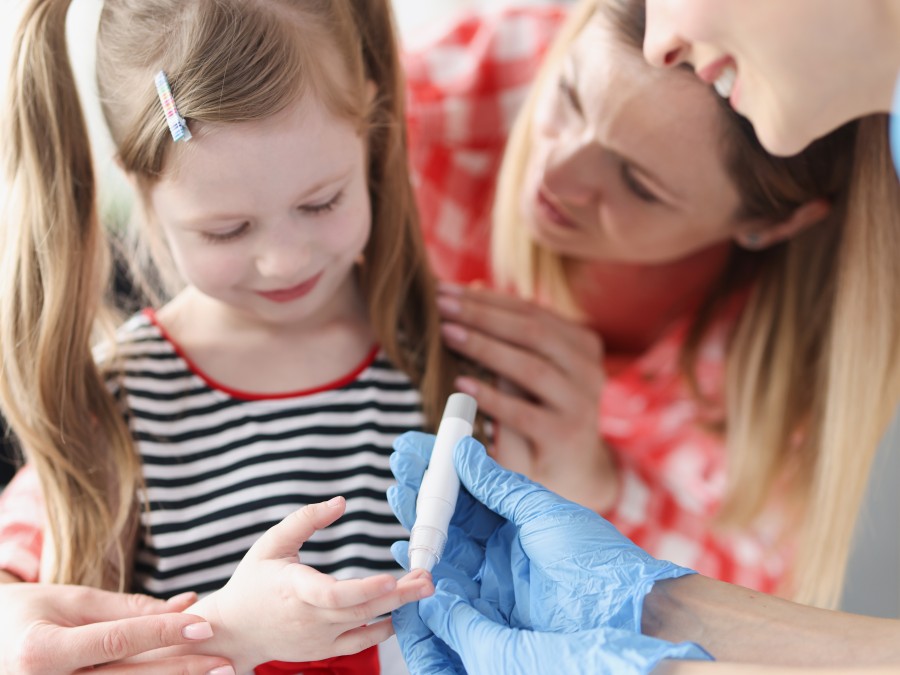The daily lives of children with diabetes

A diagnosis of diabetes for a child can transform a family's routine. From the moment the condition is discovered, a journey starts where essential foundations such as medical treatment, ongoing learning and emotional support are established. Contrary to what one might think, the daily management of childhood diabetes does not consist solely of insulin treatment. It involves detailed monitoring, education of the child and their surroundings, a balanced dietary intake, safety in sports activities and above all building a full and healthy life for the child.
Treatment: where it all starts
Treatment, for the vast majority of children with diabetes, consists of daily administration of insulin¹. This can be done with multiple injections throughout the day, or via an insulin pump, which provides a continuous and adjustable insulin supply. The method chosen will depend on the child's age, their lifestyle, and the medical team's recommendations.
The treatment must be flexible and can be adapted to changes in the child's body: growth, appetite, school times and physical activity. Constant and open communication with the paediatric endocrinologist and diabetes management team is therefore very important. A well-adjusted treatment and support process not only improves glucose management but also helps to prevent long-term complications¹.
2. Glucose monitoring: information is power
Monitoring glucose levels several times a day is one of the most important tasks in daily management. Glucose levels can be monitored either by fingerstick tests, which measure blood glucose, or by continuous glucose monitoring (CGM) devices, which measure glucose concentration in the interstitial fluid.
Thanks to technological advances, many children nowadays use CGM devices that provide near-real-time readings and trend alerts that help anticipate potential hypo- or hyperglycaemia (excessively low or high glucose)². This technology enables swift action to be taken and helps in making more precise decisions about nutrition and insulin administration.
In cases where a CGM is not available, controls with a glucometer are still highly effective. The ideal times for measuring glucose are before and after every meal, before physical exercise and at bedtime. This information not only helps to keep glucose within safe ranges, it also empowers the child to interpret the messages sent by their own bodies².
A key factor is drawing up a diabetes management plan in collaboration with a diabetes management team of healthcare professionals, in which the glucose targets, measurement guidelines, dietary intake, insulin administration and emergency protocols are defined. It's a good idea to share the plan with the school, carers and close family members to ensure a safe and supportive environment at all times².
3. Dietary intake: a balanced routine, not a restriction
One very common myth is that a child with diabetes has to follow a strict and monotonous diet, when, in fact, with some degree of planning, a child can enjoy a wide range of delicious meals. The most important thing is to be aware of carbohydrate intake, as it has a direct effect on glucose levels.
The key lies in learning to read labels, identing adequate portions, choosing foods with a low glycaemic index and accurately counting carbohydrates, which supports proper insulin dosing and helps maintain stable glucose levels. Whole-grain cereals, whole fruit, legumes, vegetables, lean protein sources and healthy fats are allies in glucose control. On the other hand, it's best to avoid simple sugars, ultra-processed foods and sugary drinks.
An individual dietary plan according to each child's individual needs, preferences and routine can be established with the help of a dietitian as part of the diabetes management team.
4. Physical activity: moving your body, watching your sugar
Regular exercise is another essential element in treatment. It improves insulin sensitivity, strengthens the cardiovascular system, improves body composition and has a positive impact on emotional wellbeing³. However, physical activity for children with diabetes needs to be carefully planned.
It's important to monitor glucose levels before, during and after activity. Aim to start physical activity in a safe glucose range determined by the child’s diabetes management team. Increased insulin sensitivity means the risk of hypoglycaemia is higher during and up to 24 hours after exercise. Be prepared to treat lows with fast acting carbohydrates ³.It's also highly recommended to inform physical education teachers and trainers about the child's diabetes and how to act in the event of hypoglycaemia³.
5. Education and emotional support: the foundations for autonomy
One of the most important aspects of managing childhood diabetes is ongoing education for the child and their caregivers. Learning about diabetes enables the child to participate in caring for their own health, making informed decisions and gradually acquiring autonomy⁴.
A child can be taught from an early age to recognise symptoms of hypoglycaemia, identify foods that raise or lower glucose levels, and understand why they have to inject themselves with insulin. As they grow older, they can learn to measure their glucose, adjust doses under supervision and eventually manage their own treatment with almost complete independence⁴.
Attention also needs to be paid to the emotional aspects. Diabetes can cause frustration, anxiety and isolation, especially during adolescence. That's why help from psychologists, support groups and social networks specifically for young people with diabetes can make all the difference. Family members, friends and teaching staff can also help by showing understanding and empathy⁴.
The daily management of childhood diabetes goes way beyond medical management. It requires commitment, constant learning and a solid support network. When adequate tools are provided — personalised treatment, effective monitoring, nutritional education, planned physical activity and emotional support — a child living with diabetes can have a full, safe and happy life.
The challenge lies not just in keeping glucose levels under control, but also in building trust, encouraging independence and offering security so that any child can grow without being limited by having diabetes.
Sources
- World Health Organization. Diabetes https://www.who.int/news-room/fact-sheets/detail/diabetes
- Centers for Disease Control and Prevention. Diabetes. https://www.cdc.gov/diabetes/
- American Diabetes Association. Diabetes. https://diabetes.org/
- National Library of Medicine. Diabetes. MedlinePlus. https://medlineplus.gov/diabetes.html





